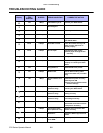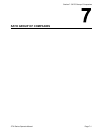
Unit 6: Maintenance
CT4i Series Operator Manual 6-2
CLEANING PROCEDURES
Cleaning of the printer is a necessary maintenance activity to ensure print quality and longer printer life. There are
two basic types of cleaning involved; the removal of loose debris and the removal of residue.
Use a soft cloth and/or a pneumatic blower to remove debris from the printer. This process should be performed
prior to the removal of residue. To remove residue, apply SATO Solvent (available separately) or isopropryl alcohol
to a clean cotton swab and gently wipe the entire surface of the print head and platen roller clean.
Of particular importance is the care and maintenance of Print Heads. Efforts should be made to educate
printer operators and their supervisors to refer to this Operator's Manual or other relevant documentation
when cleaning the print head, platen and rollers. Regular cleaning regimes should be enforced to make
sure that he printer and the immediate production area are cleaned regularly to minimize dust buildup.
Properly adjustment of the print head balance should be done periodically, and the use of certified SATO
consumables will maximize output quality and minimize print head replacement. For pre-printed labels,
ensure that ad-hoc testing is conducted so that the materials are print-head safe.
Finally, efforts should be made to ensure that operators and their supervisors do not compensate for
print quality problems by adjusting print darkness/print speed settings unnecessarily. When print heads
show signs of problems, do not allow them to continue being used. To this end, SATO Service Contracts
are highly recommended, to help businesses to reduce downtime while maximizing the durability and
usable life of the printer.
Figure 6-1, Print Head Replacement
WARNING: DISCONNECT POWER TO THE PRINTER AND ALLOW THE LATTER
TO COOL TO ROOM TEMPERATURE PRIOR TO CLEANING. EXCERSIZE CARE
WHEN CLEANING TO PREVENT PERSONAL INJURY.
CAUTION: IF USING A PNEUMATIC BLOWER TO REMOVE DEBRIS FROM THE
PRINTER, EXCERSIZE CARE TO PREVENT PRINT HEAD DAMAGE.


















